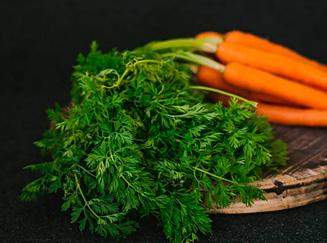
3 minute read
A spoonful of warmth
from 2018-06 Melbourne
by Indian Link
Khichdi With Carrot Greens
BY DHANYA SAMUEL
Khichdi, a quintessential winter dish from the Indian subcontinent that ironically, isn’t considered the perfect meal just for the cold season but every season. The reason is simple: it’s a comfort dish, and comfort is never season-dependent, is it?
A savoury, creamy, mish-mash of lentils and rice, tempered with spices and aromatics and a final drizzle of pure ghee.
While khichdi is a very popular dish in many parts of northern and north-eastern India, it is not so common down south where there are other rice and lentil dishes that are much sought after. It’s a fine example of ‘one man’s ordinary is another man’s exotic!’
At its heart, khichdi is an unassuming dish of rice and lentils cooked together, but it’s the tempering that makes all the difference. It can be as simple or as complex as you want and in my opinion, the flavour profile of the khichdi depends on it.
This version of the khichdi is not the most traditional but neither a fusion. It is perhaps an amalgamation of various styles based on flavours and spices that I like best.
Khichdi is an extremely healthy dish because of its powerful combination of carbs and proteins. Although usually prepared with just one type of lentils, this version has a mixture of lentils and pulses along with some sort of greens like spinach, fenugreek or even carrot greens. You can either make a mix of the lentils from what you have at home or pick up a packet of the soup mix that is easily available in all supermarkets. Or use just one type of lentil, it’s up to you. When using a soup mix, it’s best to soak it overnight so that it cooks a lot faster. Carrot greens, which have recently garnered a lot of attention with the raw food movement, are often found as an ingredient in salads, pesto, etc. But I also love using it in my dal (lentil) preparations just the way I would use spinach. Beetroot leaves can also be used this way but need to be cooked more than the carrot greens.
Even though I pressure cook the lentils and rice for time constraints, I always slow cook for a good 15-20 minutes after adding the tempering. A bit of extra time only helps intensify the flavours which I really want from my plate of khichdi. And a final drizzle of hot ghee is an absolute must!
Ingredients
1 cup mixed lentils; washed and soaked overnight
½ cup medium grain white rice
Carrot greens (I used the greens from 4 small carrots); chopped

Salt, to season
Ghee/clari ed butter; for serving
2 tbsp coriander leaves; nely chopped
For tempering
2 tbsp ghee/clari ed butter
2 tbsp vegetable oil
1 tsp mustard seeds
½ tsp cumin seeds
½ tsp caraway/shahi jeera seeds
2 dry red chilli
3 large shallots/small onion; nely chopped
1 tbsp grated garlic
1 tbsp grated ginger
2 large ripe red tomatoes; nely chopped
½ tsp turmeric powder
½ tsp Kashmiri chilli powder
½ tsp red chilli powder
A pinch of asafoetida
½ inch piece of jaggery or ½ tsp raw sugar
Method
Wash the soaked lentils and rice together. Add to a pressure cooker or deep bottom pan and cook well with enough water (remember to season with a pinch of salt). The lentils and rice must be cooked enough to be able to mash well.
In another pan, heat ghee and oil; add the mustard seeds and allow to splutter.
Then add the cumin and caraway seeds; as they begin to crackle, add the dry chillies and shallots and sauté till softened._
Then add the garlic and ginger; sauté till the onions have turned light brown. Next, add the tomatoes and cook on medium heat till the tomatoes have softened and turned mushy.
Add all the spices and jaggery; sauté till the whole masala comes together and oil starts appearing at the sides. Meanwhile, mash the lentils and rice using the back end of a ladle or a potato masher.
Add the chopped greens along with the masala to the lentils and mix well; season with salt if necessary. Add more water if necessary and cook on the low heat for 10-15 minutes.
Finish off with the chopped coriander leaves.
Serve warm with a drizzle of ghee on top. Tuck in!









